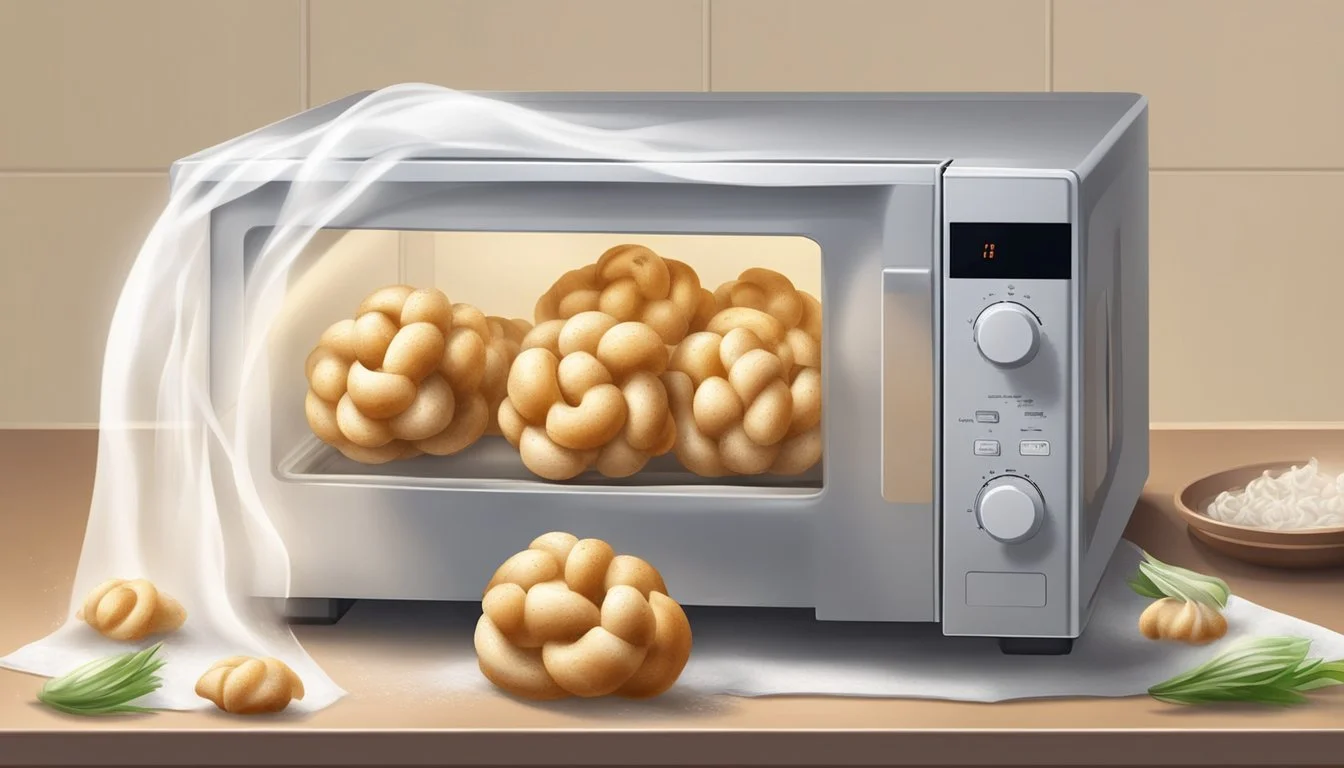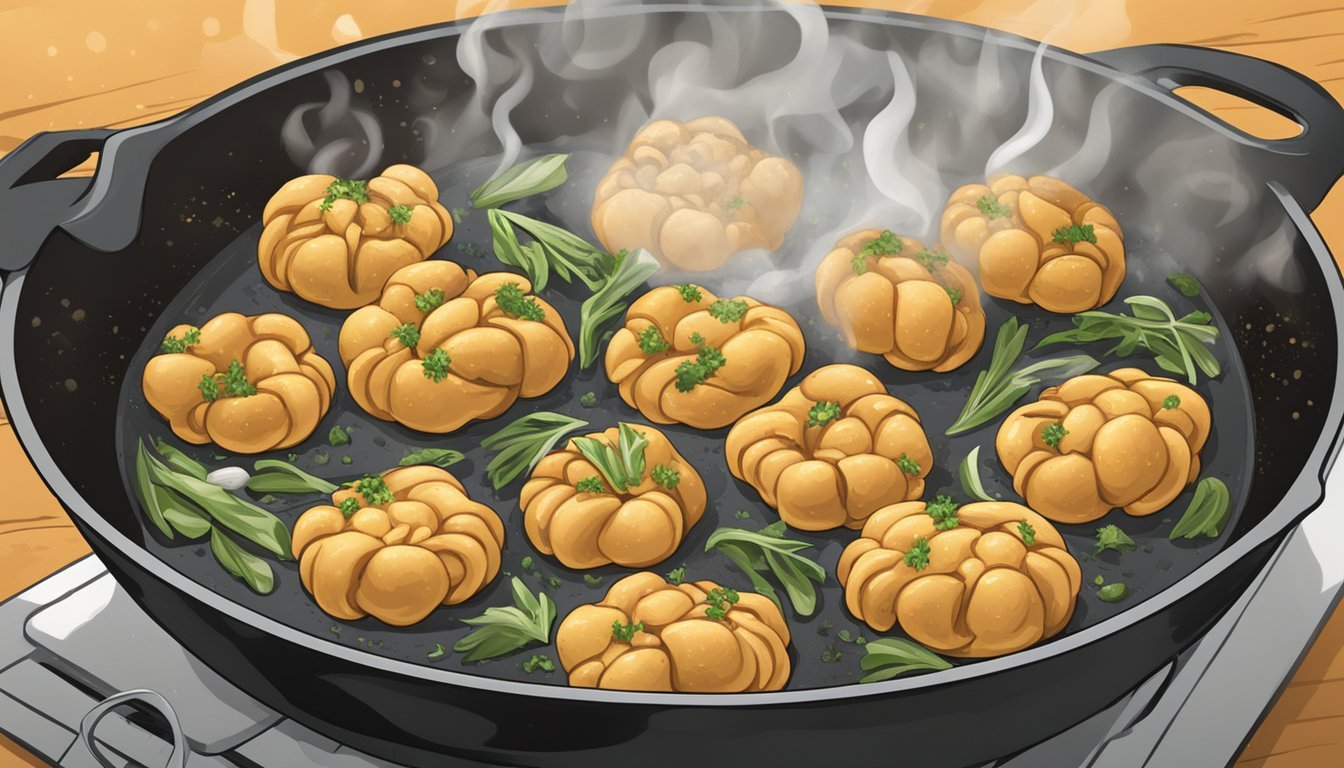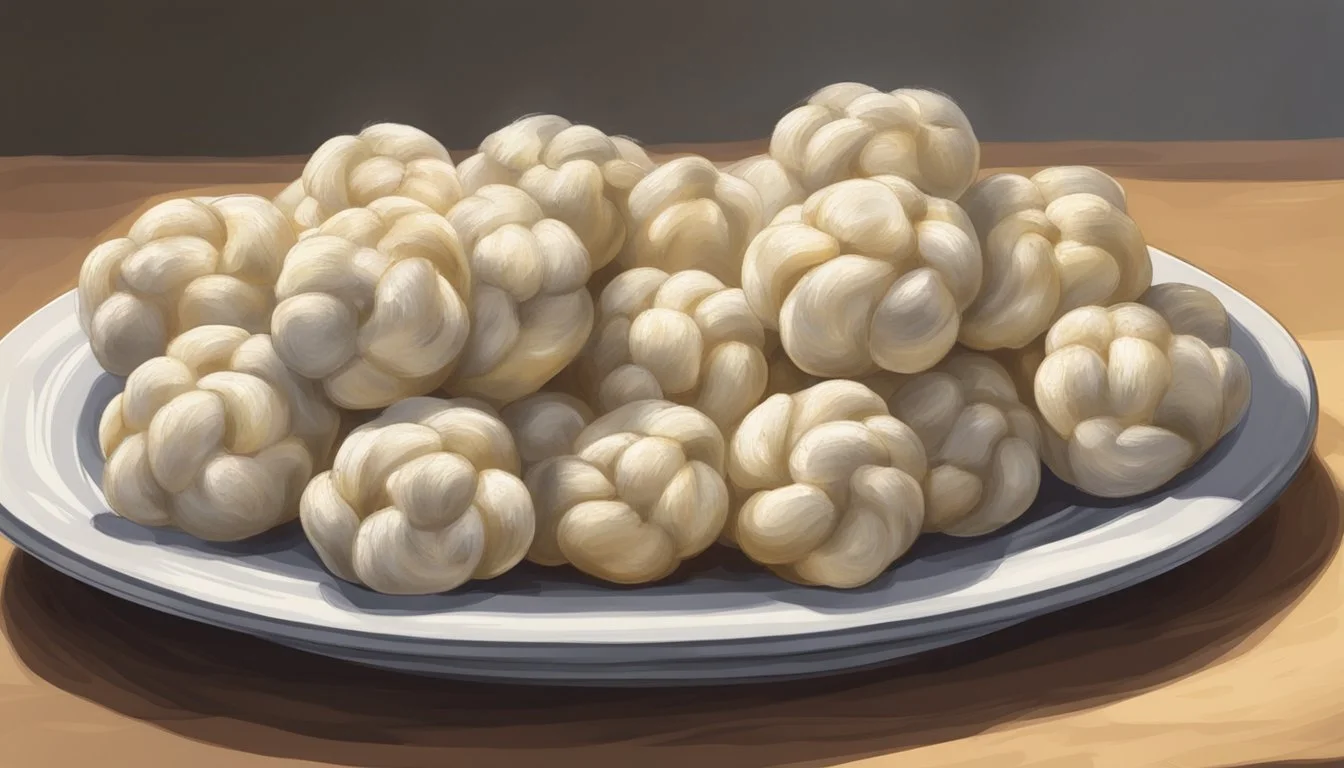Best Way to Reheat Garlic Knots
Ensuring Softness and Aroma Retention
Garlic (What wine goes well with garlic?) knots, beloved for their soft texture and aromatic allure, often find a second life as a leftover treat. Preserving their desirable qualities when reheating can be a challenge. But it is possible to enjoy these flavorful knots just as much the second time around with the right method.
Reheating garlic knots in the microwave offers convenience but requires a watchful eye to avoid rubbery results. Alternatively, using an oven can return the knots to their original state of pillowy softness and warmth while maintaining that distinctive garlic scent. The key is to employ techniques that not only warm the knots throughout but also restore the moisture lost during refrigeration.
The nuances of reheating garlic knots are numerous, but a comprehensive approach ensures that they remain tender and fragrant. Whether using a microwave for speed or an oven for even heating, one can achieve satisfying results by understanding the essentials of temperature control, moisture retention, and timing.
Understanding Garlic Knots
Garlic knots are a beloved side dish in many Italian-American restaurants, revered for their aromatic flavor and soft texture. These savory treats play a complementary role to a variety of main courses, most notably pizza and pasta.
Characteristics of Garlic Knots
Garlic knots are made from pizza dough which is tied into a knot, baked until golden, and then typically tossed in a mixture of melted butter, garlic, and parsley. They possess a golden-brown crust and a soft, chewy center. The flavor profile is rich in garlic with a hint of herbs, usually parsley, and they often have a glistening finish from the garlic butter sauce. Garlic knots can range in size but are generally small enough to be enjoyed in two or three bites.
Texture: Soft and chewy interior with a slightly crispy exterior
Flavor: Strong garlic with buttery and herby undertones
Appearance: Golden-brown color and shiny, oily surface
Relation to Pizza and Pasta
Garlic knots share a close relationship with pizza due to their common main ingredient, pizza dough. They are considered an ideal accompaniment to pizza as they use the same base but offer a different taste and texture experience.
As for pasta, garlic knots serve as the perfect side dish. The garlic flavor pairs well with both tomato and cream-based pasta sauces, and the knots are excellent for soaking up excess sauce. Additionally, they add a different mouthfeel and ease of eating compared to the more common garlic bread. In many ways, garlic knots bridge the gap between pizza and pasta, bringing a delightful and universally appreciated flavor to the dining table.
Pizza: Same dough, different form; complements the experience
Pasta: Enhances the meal with its absorbent texture and robust flavor
Proper Storage Techniques
Storing leftover garlic knots properly is crucial to maintaining their freshness and flavor for when it's time to reheat them. An airtight container is the cornerstone of effective storage.
Airtight Containers for Freshness
The best way to store leftover garlic knots is by placing them in an airtight container. This method keeps out moisture and other contaminants that might spoil the garlic knots or alter their texture. When choosing an airtight container, one should ensure it's clean and dry before placing the garlic knots inside.
Storage Steps:
Let the garlic knots cool to room temperature; placing them hot in a container could lead to condensation, which softens and potentially spoils the knots.
Place the garlic knots in a single layer to avoid them squishing each other, which can impact their texture.
Seal the container tightly; check for any gaps that might allow air to enter.
Transferring the garlic knots to a storage location, such as the refrigerator or a cool, dark pantry, will extend their longevity. Remember that even in an airtight container, garlic knots are best consumed within a few days to enjoy their characteristic softness and aromatic flavor.
Reheating Fundamentals
To serve garlic knots that are as aromatic and soft as when they were first baked, one must master the art of reheating. Temperature and time are critical factors that determine the success of this process.
Temperature and Time Considerations
Temperature: The ideal oven temperature for reheating garlic knots is typically 350°F (175°C). This ensures knots will gradually warm through to the center without the exterior becoming overly crisp or burnt.
Time: Garlic knots will generally require about 10-15 minutes to reheat thoroughly in the oven if they're at room temperature. If refrigerated, they may need up to 15 minutes. When using a microwave, short 30-second intervals are recommended to avoid the knots becoming tough, with a check in between intervals to ensure even reheating.
Method Temperature Time Notes Oven 350°F 10-15 min Cover with foil to keep moist. Microwave Medium-Low 30-sec intervals Spray water if stale to refresh.
Reheating garlic knots requires one to be attuned to temperature and time to reinstate their fresh-baked quality and aroma.
Oven Reheating Method
Reheating garlic knots in the oven is recommended for achieving a balance between crispness and maintaining the soft interior. Here's how to effectively use the oven method, ensuring the garlic knots retain their original texture and aroma.
Baking Sheet Usage
It is essential to use a baking sheet to evenly spread out the garlic knots. This allows for consistent heating and prevents the knots from sticking to each other or the baking surface. The user should:
Place the garlic knots on a baking sheet, ensuring they don't touch each other to promote even heating.
It's preferable to let the garlic knots come to room temperature before placing them in the oven for an even and quicker reheat.
Foil Wrapping to Retain Moisture
Wrapping the garlic knots loosely with aluminum foil can help in retaining their moisture during the reheating process. This simple step locks in the moisture, which is key to keeping the knots soft. Users should:
Cover the garlic knots loosely with a sheet of foil to create a moisture-rich environment as they reheat.
Avoid wrapping too tightly as this might steam the bread and affect the desired texture.
Oven Temperature Settings
Setting the right temperature on a conventional oven is critical to avoid drying out the garlic knots or burning them. For optimal results, the user should:
Preheat the oven to 350°F (175°C) which is the sweet spot for reheating most baked goods.
Heat the garlic knots for approximately 10-15 minutes. The exact time may vary depending on the oven and the number of knots being reheated.
Checking the knots after 10 minutes will help gauge if additional time is needed. After reheating, the garlic knots should be warm with a soft interior and slightly crispy exterior.
Toaster Oven Technique
When reheating garlic knots in a toaster oven, the goal is to maintain the perfect balance between a crispy exterior and a soft interior. This method is an excellent choice for those seeking a quick and efficient reheating process.
Similarities to Conventional Oven
The toaster oven method shares many similarities with reheating in a conventional oven. The key steps they have in common include:
Preheating: One should preheat the toaster oven to 350°F, similar to a conventional oven.
Arrangement: Carefully spread the garlic knots on a baking sheet without overcrowding to ensure even heat distribution.
Using a toaster oven still requires attention to detail to prevent the garlic knots from becoming too hard or losing their aromatic quality.
Adjustments for Toaster Oven Usage
Several specific adjustments are advisable when using a toaster oven:
Monitoring time: Due to their compact size, toaster ovens can reheat foods more quickly. It is crucial to check the garlic knots periodically to prevent overcooking.
Aluminum foil: To prevent a too crispy exterior and to capture some moisture, one might consider covering the knots loosely with aluminum foil.
The toaster oven method works well for both achieving a crispy exterior and a warm, soft center for garlic knots. It's also convenient for reheating smaller quantities without heating up a larger kitchen appliance.
Microwave Warming Tips
Using a microwave is a quick and efficient way to reheat garlic knots, but maintaining a soft texture while preventing sogginess requires precision. This section outlines the steps and considerations one should take when using the microwave method for optimal results.
Avoiding Sogginess
To avoid soggy garlic knots, one should:
Lightly spritz the garlic knots with water before heating. This adds moisture without soaking them.
Use a microwave-safe plate and lay a paper towel beneath the garlic knots to absorb excess moisture.
The goal is to achieve a balance where the steam generated by the gentle moisture helps to keep the garlic knots soft, while the paper towel prevents them from becoming soggy by drawing out extra moisture.
Timing for Optimal Reheating
Proper timing in a microwave is crucial for maintaining the texture of garlic knots. Here's a timing guide:
State of Garlic Knots Time Range At room temperature 10-15 seconds Refrigerated 20-30 seconds
Check the texture after the initial heating cycle. If not fully warm, heat in additional 10-second increments until desired warmth is reached.
Avoid overheating, as it can toughen the texture, making them chewy rather than soft.
Skillet Method for Crispy Edges
Using a skillet to reheat garlic knots is excellent for achieving a crispy exterior while maintaining a soft interior. This method brings a toasty texture to the knots and infuses them with rich flavors.
Oil and Butter for Enhanced Flavor
One can enhance the flavor of garlic knots by adding a mixture of oil and butter to the skillet. Use a non-stick skillet over medium heat and add 1 tablespoon of olive oil and 1 tablespoon of butter. This combination allows for a crispy edge and lends a delightful aroma while preventing the knots from becoming overly greasy.
Heat: Set the stove to medium heat to warm the skillet.
Mixture: Combine the olive oil and butter in the pan.
Ensure the butter is fully melted and mixed with the oil.
Reheat:
Place the garlic knots in the skillet in a single layer.
Cook for 1-2 minutes on each side until the desired crispiness is reached.
Be attentive to prevent burning.
Using olive oil contributes a slight nuttiness, while the butter adds a creamy and rich flavor. With this method, the garlic knots not only become crisp on the edges but also remain delectably aromatic.
Air Fryer Approach
Using an air fryer to reheat garlic knots can maintain their desirable crispy texture while ensuring they remain soft inside. One benefits from the rapid air circulation the air fryer provides, which helps to warm the garlic knots quickly without making them soggy.
Achieving a Crispier Texture
When reheating garlic knots in an air fryer, it's essential to avoid overcooking, which could lead to dryness. Here are the steps to achieve a crispy texture:
Preheat the air fryer to 350°F. This step is crucial as it ensures the temperature is uniform, which is key to even cooking.
Place the garlic knots in the air fryer basket, ensuring they do not overlap, to allow the hot air to circulate properly.
Set the timer for 3-5 minutes. Keep a close watch as different appliance models may have slightly varying cooking times.
Check the texture after 3 minutes. If they aren’t crisped to your liking, continue reheating, checking every minute to avoid overcooking.
By following these steps, one should attain garlic knots that are delightfully crisp on the outside while remaining soft and aromatic on the inside.
Additional Tips and Tricks
A perfect reheating method can elevate the humble garlic knot to a delightful experience. The key lies in enhancing their softness and aroma without compromising their taste.
Using Toppings and Herbs
Toppings play a pivotal role in maintaining the garlic knots' deliciousness post-reheating. Lightly brushing the knots with olive oil can keep them moist, while a sprinkle of Parmesan cheese adds a savory complexity. For aromatic freshness, one can consider garnishing with finely chopped herbs such as parsley or basil after reheating. This not only elevates the flavor but also adds a splash of color to the presentation.
Olive oil: Brush before reheating to lock in moisture.
Parmesan cheese: Sprinkle after reheating for enhanced flavor.
Fresh herbs: Garnish after to bring aromatic freshness.
Serving Suggestions
When one serves garlic knots, pairing them with the right condiments can make a significant difference. Marinara sauce serves as a classic dipping option that complements the rich garlic flavor. It should be served warm for a comforting taste contrast. Furthermore, serving the knots alongside a protein or a salad can balance the meal.
Marinara Sauce: Warm up for dipping.
Balanced meal: Pair with a protein or a fresh salad.
By following these specific tips and tricks, one ensures that their garlic knots are not just reheated, but restored to their full flavor potential with every serving.
Safety Precautions
When reheating garlic knots, maintaining safety is crucial. This section outlines the necessary guidelines to ensure the garlic knots are not only delicious but also safe to consume after reheating.
Guidelines for Safe Reheating
Temperature Check: It is imperative to reheat garlic knots to an internal temperature of at least 165°F. This temperature ensures that any potentially harmful bacteria are eliminated.
Consistent Heating: Garlic knots should be heated evenly. Whether using an oven or microwave, they should be arranged in a single layer and potentially rotated or stirred during the reheating process to ensure uniform warmth.
Avoid Overheating: Prolonged reheating can cause garlic knots to become excessively dry or burnt. Monitor them closely to avoid overheating, which could not only impair flavor and texture but also create a risk of fire or burns.
Utensil Safety: Use oven mitts or tongs to handle hot baking sheets and garlic knots. Direct contact with hot surfaces could lead to burns.
Appliance Awareness: Always ensure that the oven, microwave, or any other heating appliance is functioning correctly to avoid the risk of electrical hazards or uneven cooking.
By following these specific guidelines, one can confidently reheat and serve garlic knots that are both safe and enjoyable.
Serving Garlic Knots
Serving garlic knots in their best form involves pairing with complementing dishes and presenting them in a way that is appealing to the senses. The key is to ensure they remain soft, aromatic, and ready to be enjoyed with the perfect accompaniments.
Pairing with Soups and Sauces
Garlic knots, with their soft inside and aromatic flavor, make the perfect side dish to a variety of soups and sauces. They excel when served with a bowl of:
Creamy Tomato Soup: The richness of the tomato pairs exceptionally well with the garlicky dough.
Velvety Marinara Sauce: Ideal for dipping, the acidity of the marinara sauce complements the buttery knots.
When serving with soup, one can place the garlic knot directly onto the soup bowl's rim or on a separate side plate.
Presentation Tips
The presentation of garlic knots can significantly enhance dining enjoyment. Here are some tips:
Butter and Garnish: Before serving, brushing garlic knots with a bit of melted butter and sprinkling them with chopped parsley can add both flavor and visual appeal.
Arrange on a Platter: Line the garlic knots on a serving platter in a circular pattern or a neat row, allowing easy access for guests to pick their own.
Remember, the use of fresh ingredients for garnishing, such as parsley, not only adds a pop of color but also introduces a fresh flavor that contrasts the rich, warm bread.
Final Thoughts
When seeking to rediscover the joy of perfectly reheated garlic knots, one must consider both the texture and flavor. The key is to maintain the delicate balance between softness and a slight outer crispiness, while also preserving that inviting aroma that makes garlic knots irresistible.
Oven Method: A steady favorite, reheating in an oven preserves the knots' exterior texture while ensuring the interior remains fluffy. Typically, the oven should be preheated to 350°F, and the knots heated for 10-15 minutes.
Cover with aluminum foil to prevent drying.
If straight from the fridge, allow for a few extra minutes.
Microwave Method: Fast and convenient, the microwave can be used effectively if done cautiously.
Place garlic knots on a microwave-safe dish.
Cover them with a damp towel to keep moisture intact.
Reheat at 50% power, check every 20-30 seconds.
Additional Tips:
Spritzing with water before reheating can bring back moisture.
Avoid over-reheating to prevent a chewy texture.
A person who adheres to these methods can achieve garlic knots that are warm, soft, and aromatic, almost as though they’ve come straight out of the bakery oven. Remembering that each kitchen appliance behaves differently, they may need to slightly adjust the timing to achieve that exact state of reheated perfection.






